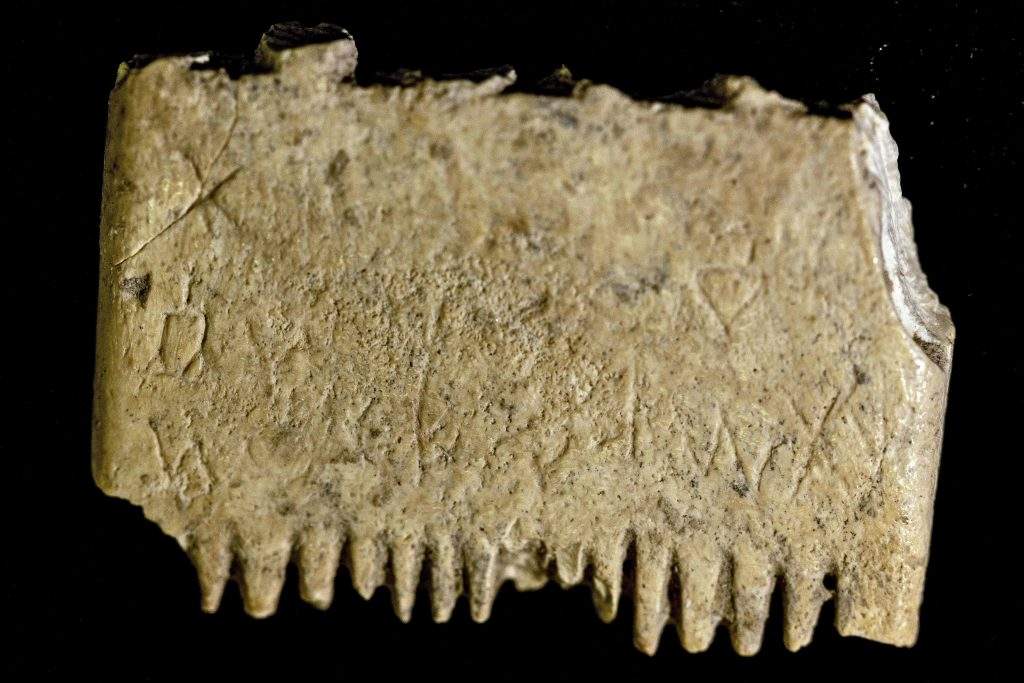A team of archaeologists from several U.S. and Israeli universities has succeeded in deciphering what to date is the oldest sentence in the world written in an alphabet. It is an inscription dating back to 1700 B.C. engraved on a small ivory comb discovered in 2016 at the archaeological site of Tel Lachish, Israel. The inscription reads, “May this comb eradicate hair and beard lice.” Not exactly a courtly phrase for being the oldest in human history written in a defined character set, and even archaeologist Michael Hasel, of Southern Adventist University in Tennessee (he is one of the authors of the discovery), who told the New York Times, “People laugh when you tell them what the inscription actually says.” It is, however, one of the oldest examples of writing from the Canaanites, an ancient Near Eastern people who are credited with developing the earliest forms of the alphabet.
The discovery was published in the Jerusalem Journal of Archaeology, an open-access Israeli scientific journal. This is not, of course, the first writing in human history, since there were earlier forms of writing (such as the cuneiform writing of the Sumerians or the hieroglyphics of the Egyptians), dating back more than a thousand years before the Canaanite alphabet: however, these were systems based on images, while the Canaanite alphabet is the earliest known alphabet, based on characters corresponding to phonemes. A writing system, in short, that was revolutionary: because it opened up the possibility of storing a few characters, instead of the hundreds of images needed with earlier scripts.
However, we do not know how this early alphabet developed: it was probably invented, according to the scholar Christopher Rollston of George Washington University, by peoples who spoke Semitic languages and at the same time knew the writing system of the Egyptians. This alphabet would later be adopted, some seven centuries later, by the Phoenicians: thus, it was not they who invented the alphabet. The one they used, however, was the basis of some character systems (for example, ancient Hebrew and ancient Aramaic), which in turn underwent evolutions that led to Greek and Latin, and thus to the way we write today.
The object on which the inscription was deciphered (“I think it’s the most important object I’ve ever found in my excavations,” said Yosef Garfinkel, an archaeologist at the Hebrew University of Jerusalem) had been found along with dozens of other artifacts, inventoried and then set aside as is often the case with finds of everyday material. The discovery of the inscription came about by accident, according to the New York Times’ continuing account: archaeologist Madeleine Mumcuoglu, of the Hebrew University of Jerusalem, had the idea of enlarging the comb under a microscope, because she wanted to see if there were any lice remains stuck to it. So, to prepare for the work, she began analyzing some photographs of the comb that she had taken with her cell phone and noticed the writing. So she sent the photographs to Daniel Vainstub, a paleographer at Ben-Gurion University, who recognized the letters of the Canaanite alphabet. And thus began the story of discovery. “Everyone had the comb in their hands, but no one noticed the inscription,” Mumcuoglu said.
To decipher the inscription, Dr. Vainstub compared its 17 letters to other ancient writing systems, since there are other Canaanite inscriptions from around the same period, but they are very fragmentary and rare. Now, however, having deciphered the inscription, much more remains to be discovered: who left the inscription on the comb? What was the purpose of marking the object’s function? In short, what was the purpose of this inscription? The study does not elaborate on the reasons for the inscription, merely reporting that it “expresses the wish that the comb on which it was engraved could eradicate lice from the hair and beard of its owner.” The only thing we can be certain of is that the engraver must have been very skilled, since he managed to engrave very small letters (1-3 millimeters wide) on an ivory comb. And the importance of the discovery is undoubted: in fact, for the first time we have a whole sentence written in a language spoken by the inhabitants of Lachish, which allows us to make further comparisons with the other sources we have in order to study it. Moreover, this is a very rare written record of daily life at the time, and it is the first discovery in the region of an inscription that refers to the purpose of the object on which it was engraved: until now, in fact, only dedicatory inscriptions, or notes of possession engraved directly on the object, were known.
 |
| Israel, discovered world's oldest sentence written in an alphabet. It talks about lice... |
Warning: the translation into English of the original Italian article was created using automatic tools. We undertake to review all articles, but we do not guarantee the total absence of inaccuracies in the translation due to the program. You can find the original by clicking on the ITA button. If you find any mistake,please contact us.